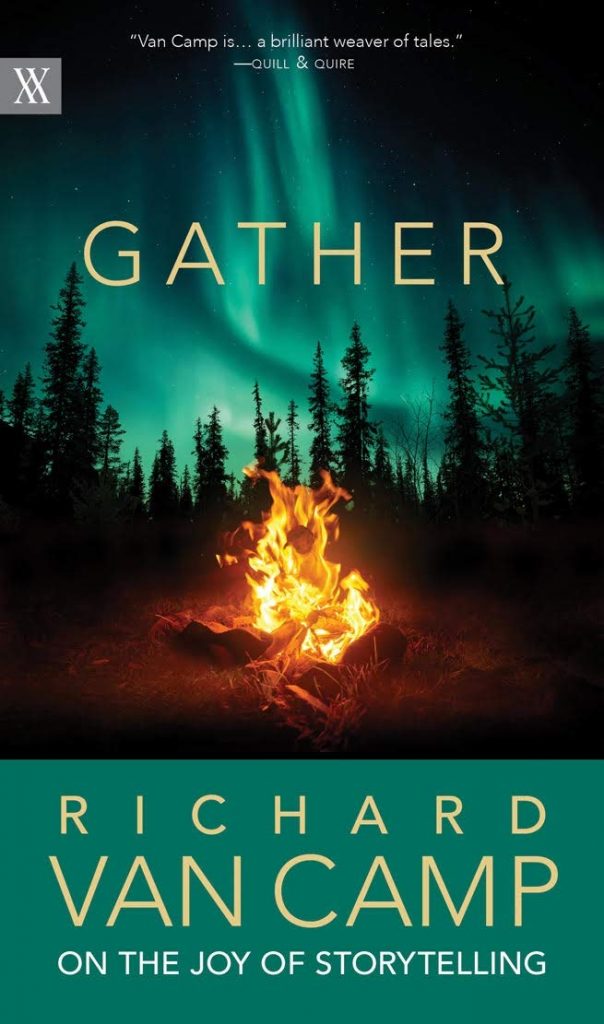
Gather: Richard Van Camp on the Joy of Storytelling
Richard Van Camp
University of Regina Press, May 2021
$19.95
Indigenous Peoples have a very strong tradition of oral storytelling. Many Indigenous cultures of Turtle Island had no written languages before European contact. They used storytelling to pass down knowledge and history. Gather by Richard Van Camp reads like a perfect translation of this traditional form of storytelling into written text.
Van Camp’s writing style in Gather is effortlessly conversational. Van Camp is passionate and energetic about storytelling. His use of the phrase “holey canoley” throughout the book shows the excitement he has for his stories.
Gather is unconventional in that there is no overarching story. The structure is a mix of short stories and storytelling advice. Van Camp even gives the reader homework throughout the book. One of these assignments relates to how he first became a storyteller. He began recording the Elders of his hometown of Fort Smith, Northwest Territories, while driving the Handi-Bus.
Many of the stories in Gather are transcriptions of interviews done by Van Camp over the years. These stories discuss Indigenous beliefs, including Traditional Stories, the Creator, and guardian spirits.
Anna Tonasket, a fellow Indigenous storyteller, recalls the time when she was saved from danger by mysterious guardian spirits known as the “Little People.” This conversation is one of many Van Camp has uploaded onto his SoundCloud account. By comparing the recordings to the book, it’s clear how few changes Van Camp makes from the original story. In a review of Gather, Keith Foster of Your West Central Voice suggests Van Camp might record his own voice when writing to achieve his conversational style.
The stories not only discuss the beliefs of Indigenous Peoples, but also the issues they continue to face. Glen Douglas — an Okanagan World War II, Korean War, and Vietnam War veteran — gives a heartfelt description of the struggle between Indigenous Peoples and the Canadian government.
A pivotal moment of the book is a transcript of Van Camp interviewing his mother, Rosa, about her experience of being sent to a residential school at five years old. Van Camp was 44 when he worked up the courage to ask her about her residential school experience. With the trauma of the residential schools still casting its shadow over Canada, stories like Rosa’s are important.
Storytelling chapters make up most of the second half of the book, while the first half gives advice on storytelling. The short chapters often flow directly into each other. One chapter that feels lacking is when Van Camp gives the reader homework of creating a calendar of events happening in their community. He then uses the next eight pages to list everything verbatim from his calendar from his hometown. Readers may find this chapter monotonous and find themselves skipping over pages.
Gather is a natural transition from oral storytelling to text. It comes at a time when the world is still dealing with the COVID-19 pandemic. Many people have felt isolated and alone over the last two years. Van Camp summarizes why community and storytelling matter through an Indigenous lens:
“To reaffirm what we already know and what COVID taught us or reminded us of: We need community, we deserve dear friends, and we don’t need more stuff. Instead, we need more stories, more teachings, more visits, more feasts, more recipe sharing, more laughs, more cookouts, more shore lunches, more family songs, and more time with those who carry our hearts.”
Gather is a pleasant read for those interested in storytelling. Gather’s title and cover perfectly convey the book’s feel — it’s like readers are gathered around a campfire while Van Camp sits in the circle telling stories.
